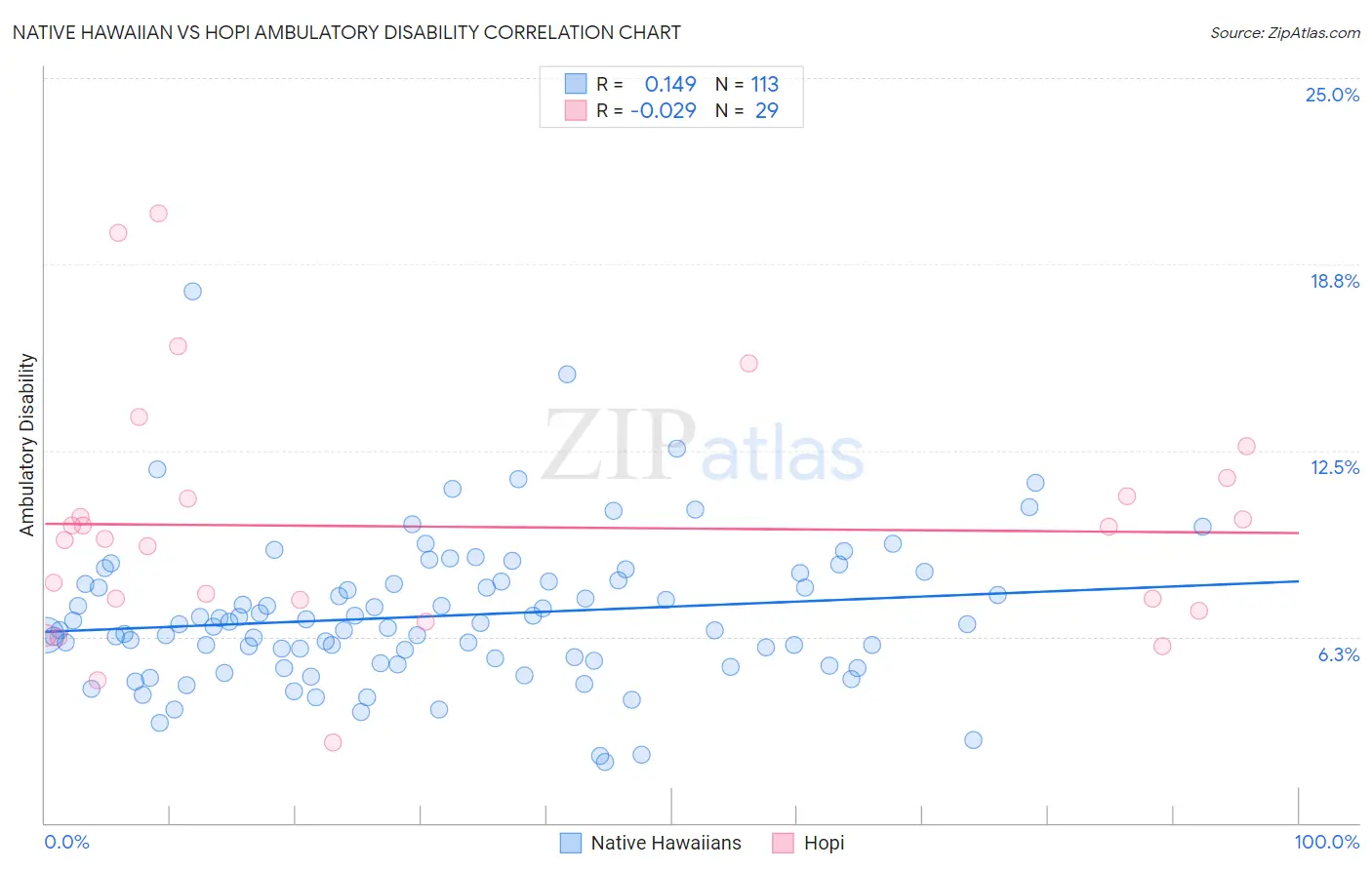Native Hawaiian vs Hopi Ambulatory Disability
COMPARE
Native Hawaiian
Hopi
Ambulatory Disability
Ambulatory Disability Comparison
Native Hawaiians
Hopi
6.5%
AMBULATORY DISABILITY
1.1/ 100
METRIC RATING
249th/ 347
METRIC RANK
7.6%
AMBULATORY DISABILITY
0.0/ 100
METRIC RATING
328th/ 347
METRIC RANK
Native Hawaiian vs Hopi Ambulatory Disability Correlation Chart
The statistical analysis conducted on geographies consisting of 331,921,721 people shows a poor positive correlation between the proportion of Native Hawaiians and percentage of population with ambulatory disability in the United States with a correlation coefficient (R) of 0.149 and weighted average of 6.5%. Similarly, the statistical analysis conducted on geographies consisting of 74,727,187 people shows no correlation between the proportion of Hopi and percentage of population with ambulatory disability in the United States with a correlation coefficient (R) of -0.029 and weighted average of 7.6%, a difference of 17.1%.

Ambulatory Disability Correlation Summary
| Measurement | Native Hawaiian | Hopi |
| Minimum | 2.0% | 2.7% |
| Maximum | 17.8% | 20.4% |
| Range | 15.8% | 17.7% |
| Mean | 6.9% | 9.9% |
| Median | 6.7% | 9.5% |
| Interquartile 25% (IQ1) | 5.4% | 7.3% |
| Interquartile 75% (IQ3) | 8.1% | 11.3% |
| Interquartile Range (IQR) | 2.7% | 4.0% |
| Standard Deviation (Sample) | 2.4% | 4.1% |
| Standard Deviation (Population) | 2.4% | 4.0% |
Similar Demographics by Ambulatory Disability
Demographics Similar to Native Hawaiians by Ambulatory Disability
In terms of ambulatory disability, the demographic groups most similar to Native Hawaiians are Chinese (6.5%, a difference of 0.080%), Hawaiian (6.5%, a difference of 0.26%), Immigrants from Portugal (6.5%, a difference of 0.28%), Immigrants from Cuba (6.5%, a difference of 0.30%), and Armenian (6.5%, a difference of 0.36%).
| Demographics | Rating | Rank | Ambulatory Disability |
| Spaniards | 1.6 /100 | #242 | Tragic 6.5% |
| Germans | 1.5 /100 | #243 | Tragic 6.5% |
| Immigrants | Panama | 1.5 /100 | #244 | Tragic 6.5% |
| Tlingit-Haida | 1.5 /100 | #245 | Tragic 6.5% |
| Armenians | 1.5 /100 | #246 | Tragic 6.5% |
| Immigrants | Cuba | 1.4 /100 | #247 | Tragic 6.5% |
| Immigrants | Portugal | 1.4 /100 | #248 | Tragic 6.5% |
| Native Hawaiians | 1.1 /100 | #249 | Tragic 6.5% |
| Chinese | 1.0 /100 | #250 | Tragic 6.5% |
| Hawaiians | 0.9 /100 | #251 | Tragic 6.5% |
| Immigrants | Bahamas | 0.8 /100 | #252 | Tragic 6.5% |
| Scottish | 0.7 /100 | #253 | Tragic 6.5% |
| Belizeans | 0.7 /100 | #254 | Tragic 6.5% |
| Welsh | 0.6 /100 | #255 | Tragic 6.5% |
| Immigrants | Uzbekistan | 0.6 /100 | #256 | Tragic 6.5% |
Demographics Similar to Hopi by Ambulatory Disability
In terms of ambulatory disability, the demographic groups most similar to Hopi are Pueblo (7.6%, a difference of 0.040%), Native/Alaskan (7.5%, a difference of 0.94%), Black/African American (7.5%, a difference of 0.95%), Comanche (7.5%, a difference of 1.1%), and Navajo (7.5%, a difference of 1.1%).
| Demographics | Rating | Rank | Ambulatory Disability |
| Apache | 0.0 /100 | #321 | Tragic 7.4% |
| Osage | 0.0 /100 | #322 | Tragic 7.4% |
| Americans | 0.0 /100 | #323 | Tragic 7.4% |
| Navajo | 0.0 /100 | #324 | Tragic 7.5% |
| Comanche | 0.0 /100 | #325 | Tragic 7.5% |
| Blacks/African Americans | 0.0 /100 | #326 | Tragic 7.5% |
| Natives/Alaskans | 0.0 /100 | #327 | Tragic 7.5% |
| Hopi | 0.0 /100 | #328 | Tragic 7.6% |
| Pueblo | 0.0 /100 | #329 | Tragic 7.6% |
| Paiute | 0.0 /100 | #330 | Tragic 7.7% |
| Cajuns | 0.0 /100 | #331 | Tragic 7.8% |
| Menominee | 0.0 /100 | #332 | Tragic 7.8% |
| Cherokee | 0.0 /100 | #333 | Tragic 7.9% |
| Yuman | 0.0 /100 | #334 | Tragic 7.9% |
| Chickasaw | 0.0 /100 | #335 | Tragic 8.0% |